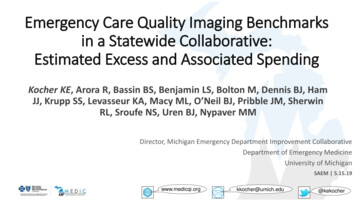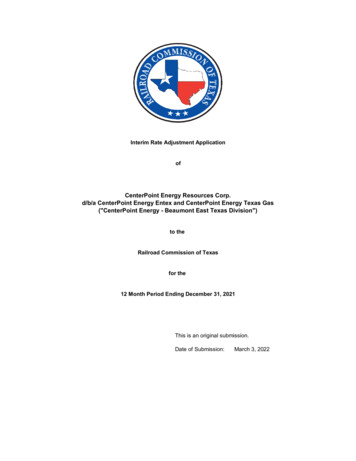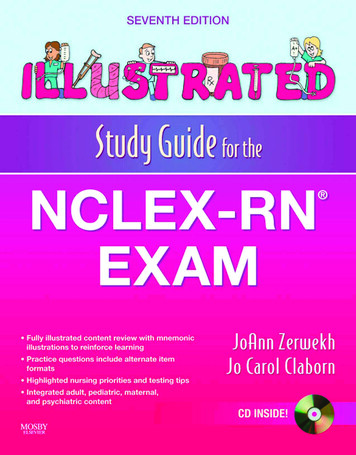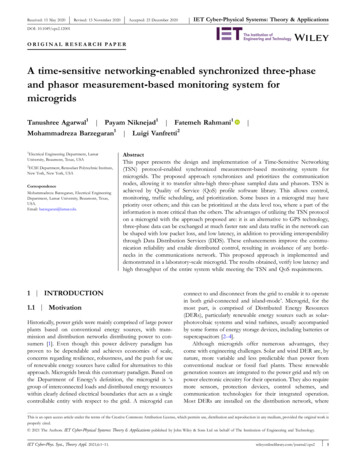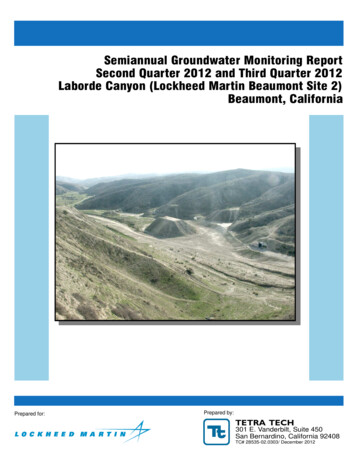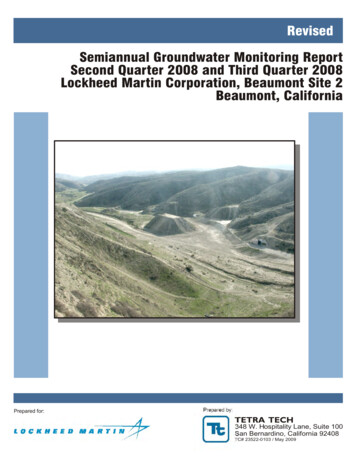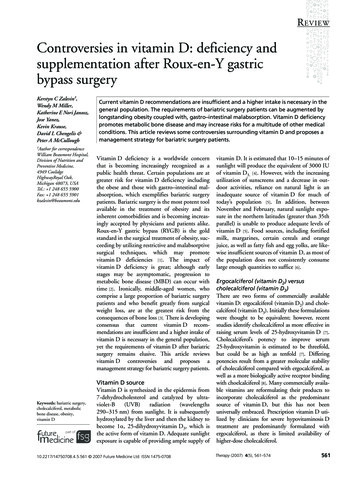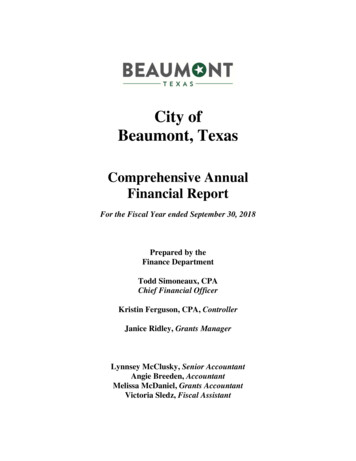
Transcription
City ofBeaumont, TexasComprehensive AnnualFinancial ReportFor the Fiscal Year ended September 30, 2018Prepared by theFinance DepartmentTodd Simoneaux, CPAChief Financial OfficerKristin Ferguson, CPA, ControllerJanice Ridley, Grants ManagerLynnsey McClusky, Senior AccountantAngie Breeden, AccountantMelissa McDaniel, Grants AccountantVictoria Sledz, Fiscal Assistant
CITY OF BEAUMONT, TEXASCOMPREHENSIVE ANNUAL FINANCIAL REPORTFOR THE FISCAL YEAR ENDED SEPTEMBER 30, 2018TABLE OF CONTENTSPageINTRODUCTORY SECTIONLetter of Transmittal . iGFOA Certificate of Achievement . viiList of Principal Officials . viiiOrganizational Chart . ixFINANCIAL SECTIONIndependent Auditor’s Report . 1Management’s Discussion and Analysis . 4BASIC FINANCIAL STATEMENTSGovernment‐wide Financial StatementsStatement of Net Position . 13Statement of Activities . 14Fund Financial StatementsBalance Sheet – Governmental Funds . 16Statement of Revenues, Expenditures, and Changes inFund Balances – Governmental Funds . 17Reconciliation of the Statement of Revenues, Expenditures, and ChangesIn Fund Balances of Governmental Funds to the Statement of Activities . 18Statement of Net Position – Proprietary Funds . 19Statement of Revenues, Expenses, and Changes inFund Net Position – Proprietary Funds . 20Statement of Cash Flows – Proprietary Funds . 21Statement of Fiduciary Net Position . 22Statement of Changes in Fiduciary Net Position . 23Notes to the Financial Statements . 24REQUIRED SUPPLEMENTAL INFORMATIONSchedule of Revenues, Expenditures and Changes in Fund BalancesBudgetary Basis (Non‐GAAP) – Budget and Actual – General Fund . 73Schedule of Changes in the City’s Net Pension Liability and Related Ratios TMRS . 74Schedule of City Contributions TMRS . 75Schedule of Changes in the City’s Net Pension Liability and Related Ratios BFRRF . 76Schedule of Contributions BFRRF . 77Schedule of Investment Returns BFRRF . 78Schedule of Changes in the City’s Other Postemployment Benefits and Related Ratios . 79Schedule of Investment Returns OPEB Trust Fund . 80
NON‐MAJOR GOVERNMENTAL FUNDSFund Definitions . 81Combining and Individual Fund Statements and SchedulesCombining Balance Sheet – Nonmajor Governmental Funds . 84Combining Statement of Revenues, Expenditures andChanges in Fund Balances – Nonmajor Governmental Funds . 92Schedules of Revenues, Expenditures, and Changes inFund Balances – Budget and ActualDebt Service Fund . 100Confiscated Goods Fund . 101Henry Homberg Golf Course Fund . 102Historical Fire Museum Trust Fund . 103Hotel Occupancy Tax Fund . 104Ike Recovery Fund . 105Library Trust Fund . 106Miscellaneous Trust Fund . 107Municipal Airport Fund . 108Municipal Court Juvenile Case Manager Fund . 109Municipal Court Security Fund . 110Municipal Court Technology Fund . 111Municipal Transit Fund . 112Public Education Government Programming Fund . 113Texas Motor Carrier Violations Fund . 114Tyrrell Historical Trust Fund . 115Julie Rogers Trust Fund . 116Library Endowment Trust Fund . 117INTERNAL SERVICE FUNDSFund Definitions . 119Combining Statement of Net Position . 120Combining Statement of Revenues, Expenses, andChanges in Fund Net Position . 122Combining Statement of Cash Flows . 124
STATISTICAL SECTIONStatistical Section Narrative . 127TABLENet Position By Component . 1Changes in Net Position . 2Fund Balances, Governmental Funds . 3Changes in Fund Balances, Governmental Funds . 4Sales Tax Revenue By Category . 5Assessed Value and Estimated Actual Value ofTaxable Property . 6Direct and Overlapping Property Tax Rates . 7Principal Property Tax Payers . 8Property Tax Levies and Collections . 9Ratio of Outstanding Debt By Type . 10Ratio of General Bonded Debt Outstanding . 11Direct and Overlapping Governmental Activities Debt . 12Pledged Revenue Coverage . 13Demographic and Economic Statistics . 14Principal Employers . 15Top Ten Water Customers . 16Full‐Time Equivalent City Government EmployeesBy Function/Program . 17Operating Indicators By Function/Program . 18Capital Asset Statistics By Function/Program . 19Active and Retiree Health Insurance Costs . 4145146147148149
March 19, 2019To the Honorable Mayor, Members of the City Council, and Citizens of the City ofBeaumont:It is our pleasure to submit the Comprehensive Annual Financial Report (CAFR) of theCity of Beaumont as of and for the year ended September 30, 2018. This report wasprepared by the Finance Department, in accordance with the City Charter, and incompliance with State law, to provide citizens, investors, grantor agencies and otherinterested parties with reliable financial information about the City.The report consists of management’s representations concerning the finances of the Cityof Beaumont. Consequently, management assumes full responsibility for the completenessand reliability of all of the information presented in this report. To provide a reasonablebasis for making these representations, management of the City of Beaumont hasestablished a comprehensive internal control framework that is designed both to protect thegovernment’s assets from loss, theft, or misuse, and to compile sufficient reliableinformation for the preparation of the City of Beaumont’s financial statements inconformity with generally accepted accounting principles (GAAP). Because the cost ofinternal controls should not outweigh their benefits, the City of Beaumont’s comprehensiveframework of internal controls has been designed to provide reasonable rather thanabsolute assurance that the financial statements will be free from material misstatement.As management, we assert that, to the best of our knowledge and belief, this financial reportis complete and reliable in all material respects.The City of Beaumont’s financial statements have been audited by BKD, LLP, a firm oflicensed certified public accountants. The goal of the independent audit was to providereasonable assurance that the financial statements of the City of Beaumont for the fiscalyear ended September 30, 2018, are free of material misstatement. The independent auditinvolved examining, on a test basis, evidence supporting the amounts and disclosures inthe financial statements; assessing the accounting principles used and significant estimatesmade by management; and evaluating the overall financial statement presentation. Basedupon the audit, the independent auditor concluded that there was a reasonable basis forrendering an unmodified opinion that the City of Beaumont’s financial statements for thefiscal year ended September 30, 2018, and that those statements are fairly presented inconformity with GAAP. The independent auditor’s report is presented as the firstcomponent of the financial section of this report.i
The independent audit of the financial statements of the City of Beaumont was a part of abroader, federally mandated “Single Audit” designed to meet the special needs of federalgrantor agencies. The standards governing Single Audit engagements require theindependent auditor to report not only on the fair presentation of the financial statements,but also on the audited government’s internal controls and compliance with legalrequirements, with special emphasis on internal controls and legal requirements involvingthe administration of federal awards. These reports are available in the City of Beaumont’sseparately issued Single Audit Report.GAAP require that management provide a narrative introduction, overview, and analysisto accompany the basic financial statements in the form of Management’s Discussion andAnalysis (MD&A). This letter of transmittal is designed to complement MD&A and shouldbe read in conjunction with it. The City of Beaumont’s MD&A can be found immediatelyafter the report of the independent auditors.PROFILE OF THE GOVERNMENTThe City of Beaumont, Texas, incorporated in 1838, is located in the southeast corner ofthe state and is the seat of Jefferson County. With a population of an estimated 120,300,the City occupies a land area of 84.01 square miles. The City has a major interstate highwaydividing it and is serviced by a major port, a regional airport and three railroad lines. ThisCity is empowered to levy a property tax on both real and personal properties located withinits boundaries and collects sales tax revenues on taxable sales and purchases. The City isalso empowered by state statute to extend its corporate limits by annexation, which occursperiodically when deemed appropriate by the governing council.The City has a Council-Manager form of government. It is governed by an elected Councilcomposed of a Mayor and six council members, who each serve two-year terms. Fourcouncil members serve a separate ward district, and two serve at-large. They are chargedwith formulating public policy, enacting local legislation, adopting budgets, and appointingthe City Manager, City Attorney, City Clerk and City Magistrates. The City Manager isthe chief administrative and executive officer of the City, and implements Councildirectives and policies, administers the fiscal affairs, and is responsible for theadministration of the municipal operations.The City of Beaumont provides a full range of services, including police and fireprotection; construction and maintenance of streets and other infrastructure; recreationalactivities; health and welfare services; and cultural events.The annual budget serves as the foundation for the City of Beaumont’s financial planningand control. All departments of the City are required to submit requests for appropriationto the City Manager on or before May 15 of each year. The City Manager uses theserequests as the starting point for developing a proposed budget which is presented to theCouncil for review by August 15. The Council is required to hold public hearings on theproposed budget and to adopt a final budget no later than September 27, in the last monthof the City of Beaumont’s fiscal year. The appropriated budget is prepared by fund,ii
function, (e.g. public safety), and department (e.g. police). Transfers between expenditureaccounts within a department may occur with the approval of the Department Director andreview of the Budget Officer. Transfers between operating departments may occur withinthe same fund with the approval of the City Manager. Transfers of appropriations betweenfunds, however, require the special approval of the City Council. Budget-to-actualcomparisons are provided in this report for each individual governmental fund for whichan appropriated annual budget has been adopted. For the General Fund, this comparison ispresented on page 73 of the required supplementary information section of the report. Forgovernmental funds, other than the General Fund, with appropriated annual budgets, thiscomparison is presented in the governmental fund subsection of this report, which starts onpage 100.HistoryIn 1835, Henry Millard, Joseph Pulsifer and Thomas Huling visited two small communitieslocated on the banks of the Neches River with the hopes of starting a mercantile business.Given a tour of the riverfront property, Millard and his partners recognized its potentialand purchased the property for 500, naming the town “Beaumont” after his late wife“Mary Beaumont.” However, plans for the development of the new town were abruptlyhalted by the onset of the Texas Revolution.Returning from war, Millard continued his quest to establish the settlement. On December16, 1838, by an act of the Third Congress of the Republic of Texas, the City of Beaumontreceived its charter. By August 1840, the first elected officials were sworn in. Order ofbusiness was promptly addressed with passage of the first ordinance establishing a liabilityfor removing carcasses of cattle that drowned while being driven across the Neches. Bythe early 1900's Beaumont came of age when the first great oil well of the world, theAnthony F. Lucas Gusher, blew in at Spindletop. With the discovery of oil at Spindletop,Beaumont’s population exploded.The early 1920's were hard and the citizens of Beaumont were met with many adversities.They fought an epidemic of the bubonic plague brought on by one of the ships docked inthe port and had to replace the wooden streets with asphalt and concrete after the town wasdestroyed by a flood. By the latter part of the decade, the City enjoyed an economic growthspurred by the growing oil economy. Good times were short-lived, however, because in1929 the stock market crashed and started the Great Depression. During World War II,wartime changes again brought prosperity to Beaumont. Local industries such as oilrefining and manufacturing and shipbuilding experienced increased production whichcaused an expanded population.The 1960’s and 1970’s were years of both torment and triumph. The area, now referred toas the Golden Triangle, had become the petrochemical complex of Southeast Texas. In1971, Beaumont approved its first bond issue since 1921, totaling 12 Million. By 1975,the economy had progressed so far that the nationwide recession had little effect on thearea. In 1978, Beaumont was named by Money magazine as the town with the mostpotential for growth in the entire country.iii
During 1982, the local economy began to slide into the deepest recession since the GreatDepression. Tens of thousands of jobs in the chemical, petroleum, shipbuilding, and oildrilling industries were lost. By 1987, the recession reached its deepest point, and a steadysustainable recovery had begun and continued through the early 2000’s.In the summer of 2005, as Beaumont was assisting with the housing of evacuees fromHurricane Katrina, the City was dealt a major blow of its own when it took a direct hit fromHurricane Rita. Many homes and businesses suffered major damage or were completelydestroyed by winds and downed trees. Most of the electrical utility grid andtelecommunications throughout the area were destroyed and had to be rebuilt. Thousandsof workers from other parts of the country descended on the area to help rebuild.Residential and commercial construction was soon at an all-time high for hotels and newand remodeled homes, with a need not only to accommodate the increasing labor force, butto replace those structures that had been destroyed. Businesses flourished with renewedactivity. As the area attempted to return to a normal life, we were soon forced to deal withthe arrival of Hurricanes Humberto in 2007 and Gustav and Ike in 2008. While Humbertowas a relatively minor storm, and Gustav skirted the eastern edge of the area, Ike was acompletely different story. As one of the largest and most devastating storms in history,encompassing the entire Gulf of Mexico at one point, the storm surge completelyobliterated some areas around Beaumont. While the damage in the City itself was not assevere as with Rita, many residents had to relocate, businesses were closed and therebuilding began again. Nine years later in August 2017, Hurricane Harvey, a category 4hurricane made landfall on the Texas gulf coast. After striking land, Harvey weakened toa tropical storm and for about two days stalled over Southeast Texas dropping very heavyrainfall and causing widespread flooding.While striving to return to pre-storm conditions, the City of Beaumont is committed tofuture development city-wide.Factors Affecting Financial ConditionsThe information presented in the financial statements is perhaps best understood when it isconsidered from the broader perspective of the specific environment within which the Cityoperates. The City, its area residents, and local businesses continue their recovery effortsfrom the impact of Hurricane Harvey in August 2017. This restoration has been acombination of repairs to return structures to pre-storm conditions and major renovations.As a result of this activity, Beaumont has experienced an increase in sales tax revenueresulting in a major financial boost.Although Beaumont's economy continues to be dominated by the petrochemical industry,employment trends show a shift to service-oriented jobs. This shift from manufacturing isconsistent with national trends. Area chemical plants continue to upgrade and expand theirfacilities to meet increased product demand and stricter environmental controls.Multibillion-dollar investments in local energy projects have provided employment forthousands of temporary workers for several years, as well as adding hundreds of permanentpositions. New multibillion-dollar expansion projects are also being planned for the area. Thiswill have a direct impact on the housing, retail, and service markets as well.iv
Lamar University and Lamar Institute of Technology, both a part of the Texas StateUniversity System, are dedicated to providing a quality education for all who seek it.Satisfying the demand for qualified labor has become a top priority for both, and enrollmenthas steadily increased over the past several years. With workers needed for constructionand the ensuing permanent positions, many of the specialized fields of education aretailored to meet the needs of area businesses. Lamar University has some of the best MBAand chemical engineering programs in the county, with plans for a new degree program inenergy engineering.Beaumont has much to offer. City officials and the Greater Beaumont Chamber ofCommerce continue to aggressively market our community to business and industry. Afour-year university and one of the fastest-growing technical colleges in Texas provide thebasis for an educated and skilled workforce to meet the requirements of companiescompeting in a global economy.Long-term financial planningBy charter, the City of Beaumont maintains a five-year Capital Program which serves asits planning document to ensure that its facilities, streets and water and sewer infrastructureare well maintained. The Capital Program is prepared annually to provide for both shortand long range physical development within the City. As included in the 2019 CapitalProgram, there are approximately 118.5 million of street/drainage, water/sewer andfacility improvements in the design or construction phase.Relevant financial policiesThe City of Beaumont has adopted a comprehensive set of financial policies. During thecurrent year, two of these policies were particularly relevant. The City of Beaumont has apolicy that requires any budget amendments calling for new fund appropriations thatexceed unencumbered fund balances to be approved by the City Council. In August 2018,due to unforeseen expenditures, council approved budget amendments in the followingfunds: Hotel Occupancy Tax Fund; 185,000, Water Utilities Fund; 140,000, Solid WasteFund; 400,000, Municipal Airport Fund; 500,000, Capital Reserve Fund; 100,000,Employee Benefits Fund; 200,000, Fleet Fund; 500,000 and General Liability Fund; 100,000.In addition, the City of Beaumont has a policy that requires transfers between funds mustbe accomplished by budget amendments approved by the City Council. In August 2018 inorder to strengthen the fund balance for FY 2019, transfers were approved by City Councilin the following funds: General Liability Fund; 700,000, Capital Reserve Fund; 1.8million, General Improvements Fund; 2.1 million and Henry Homberg Golf Course Fund; 300,000.v
vi
vii
City ofBeaumont, TexasList of Principal OfficialsBecky Ames, MayorRobin Mouton, Ward IV, Mayor Pro-TemBill Sam, At LargeW. L. Pate, Jr., At LargeVirginia Jordan, Ward IMike Getz, Ward IIAudwin M. Samuel, Ward IIIKyle Hayes, City Managerviii
CITY OF BEAUMONTORGANIZATIONAL CHARTCITIZENS OF BEAUMONTCITY COUNCILMAYORCOUNCILMEMBERSCITY ATTORNEYCITY MANAGERCITY CLERKLEGAL ADVISORCLAIMS LITIGATIONEXECUTIVEOFFICIAL RECORDSPUBLIC SAFETYOPERATIONSSUPPORT FUNCTIONSCOMMUNITY SERVICESPOLICEPUBLIC WORKSFINANCEPUBLIC HEALTHPatrolInvestigations911 DispatchCapital ProgramEngineeringStreets & DrainageTraffic itsBudgetingCentral CollectionsFleetMunicipal CourtPurchasingClinical ServicesEMSHealth InspectionsWICPARKS & RECREATIONEmergency OperationsTrainingPERSONNELEVENT mationTechnologyCommunications311SOLID WASTECONVENTION& VISITORS BUREAULIBRARIESANIMAL CAREPLANNING & COMMUNITYDEVELOPMENTixBuilding CodesCode EnforcementPlanningBlock GrantsHousingTransit
x
1
2
3
CITY OF BEAUMONT, TEXASManagement’s Discussion and AnalysisAs management of the City of Beaumont (the City), we offer readers of the City’s financial statementsthis narrative overview and analysis of the financial activities of the City for the fiscal year endedSeptember 30, 2018. We encourage readers to consider the information presented here in conjunctionwith our letter of transmittal at the front of this report and the City’s financial statements, which followthis section.Financial Highlights The assets and deferred outflows of resources of the City exceeded its liabilities and deferred inflowsof resources at the close of 2018 by 305 million. Of this amount, a negative 108.5 million isconsidered unrestricted. The unrestricted net position of the City’s governmental activities is anegative 109.8 million. The unrestricted net position of the City’s business-type activities is a positive 1.3 million. The net position increased by 16.8 million in 2018 prior to restatement for adoption of GASB StatementNo. 75, Accounting and Financial Reporting for Postemployment Benefits Other Than Pensions. The keyfactors for the increase were due to increased sales taxes and operating grants. As of the close of the current fiscal year, the City’s governmental funds reported a combined endingfund balance of 111 million. Approximately 39 million of the 111 million fund balance isconsidered unassigned at September 30, 2018. The General Fund reported a fund balance of 46.1 million at the end of the current fiscal year. Theunassigned fund balance for the General Fund was 45.5 million or 38.7 percent of total GeneralFund expenditures (excluding transfers out). The City’s total liabilities decreased by 12.5 million during the current fiscal. The key factor for thedecrease was due to decreases in the net pension liabilities.Overview of the Financial StatementsThis discussion and analysis is intended to serve as an introduction to the City’s basic financialstatements. The City’s basic financial statements are comprised of three components: 1) governmentwide financial statements, 2) fund financial statements, and 3) notes to the financial statements. Thisreport also contains other supplementary information in addition to the basic financial statementsthemselves.Government-wide financial statements. The government-wide financial statements are designed toprovide readers with a broad overview of the City’s finances, in a manner similar to private-sectorbusiness.The statement of net position presents information on all of the City’s assets, deferred outflows ofresources, and liabilities with the difference between the two reported as net position. Over time,increases or decreases in net position may serve as a useful indicator of whether the financial position ofthe City is improving or deteriorating.4
The statement of activities presents information showing how the government’s net position changedduring the most recent fiscal year. All changes in net position are reported as soon as the underlyingevent giving rise to the change occurs, regardless of the timing of the cash flows. Thus, revenues andexpenses are reported in this statement for some items that will only result in cash flows in future fiscalperiods (e.g., uncollected taxes and earned but unused vacation leave).Both of the government-wide financial statements distinguish functions of the City that are principallysupported by taxes and intergovernmental revenues (governmental activities) from other functions thatare intended to recover all or a significant portion of their costs through user fees and charges (businesstype activities). The governmental activities of the City include general government, public works, publicsafety, housing, economic development, health and welfare, and culture and recreation. The businesstype activities of the City include two enterprise activities: a water and sewer system, and a solid wastesystem.The government-wide financial statements can be found on pages 13 – 15 of this report.Fund financial statements. A fund is a grouping of related accounts that is used to maintain controlover resources that have been segregated for specific activiti
City is empowered to levy a property tax on bot h real and personal prope rties located within its boundaries and collects sales tax revenues on taxable sales and purchases. The City is also empowered by state statute to extend its corporate limits by annexation, which occurs periodically when deemed appropriate by the governing council.


